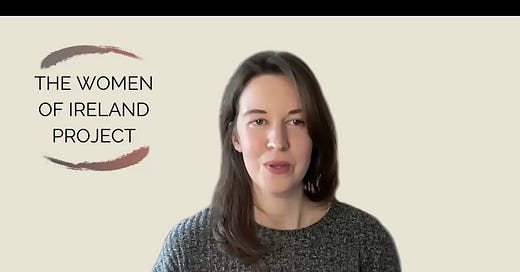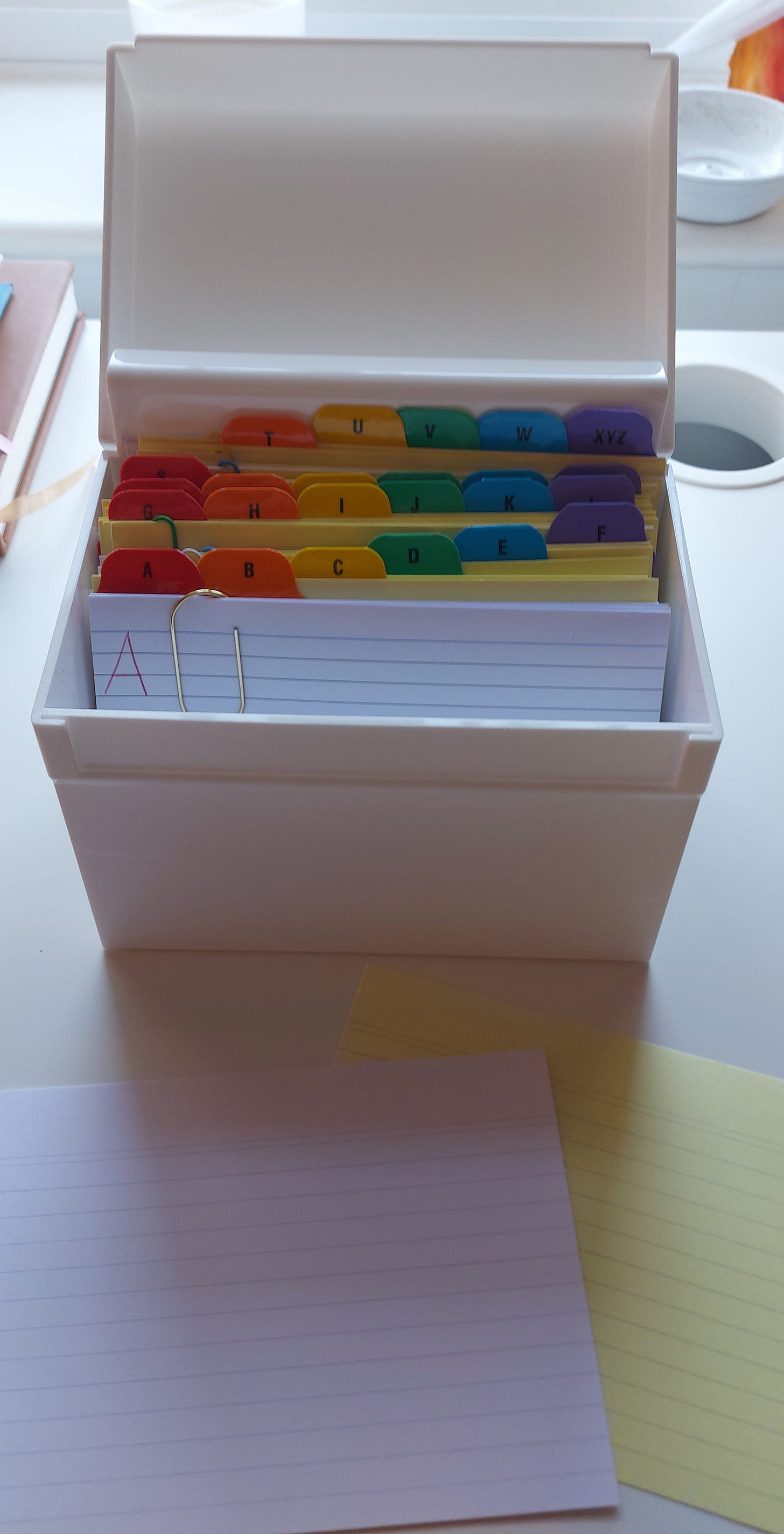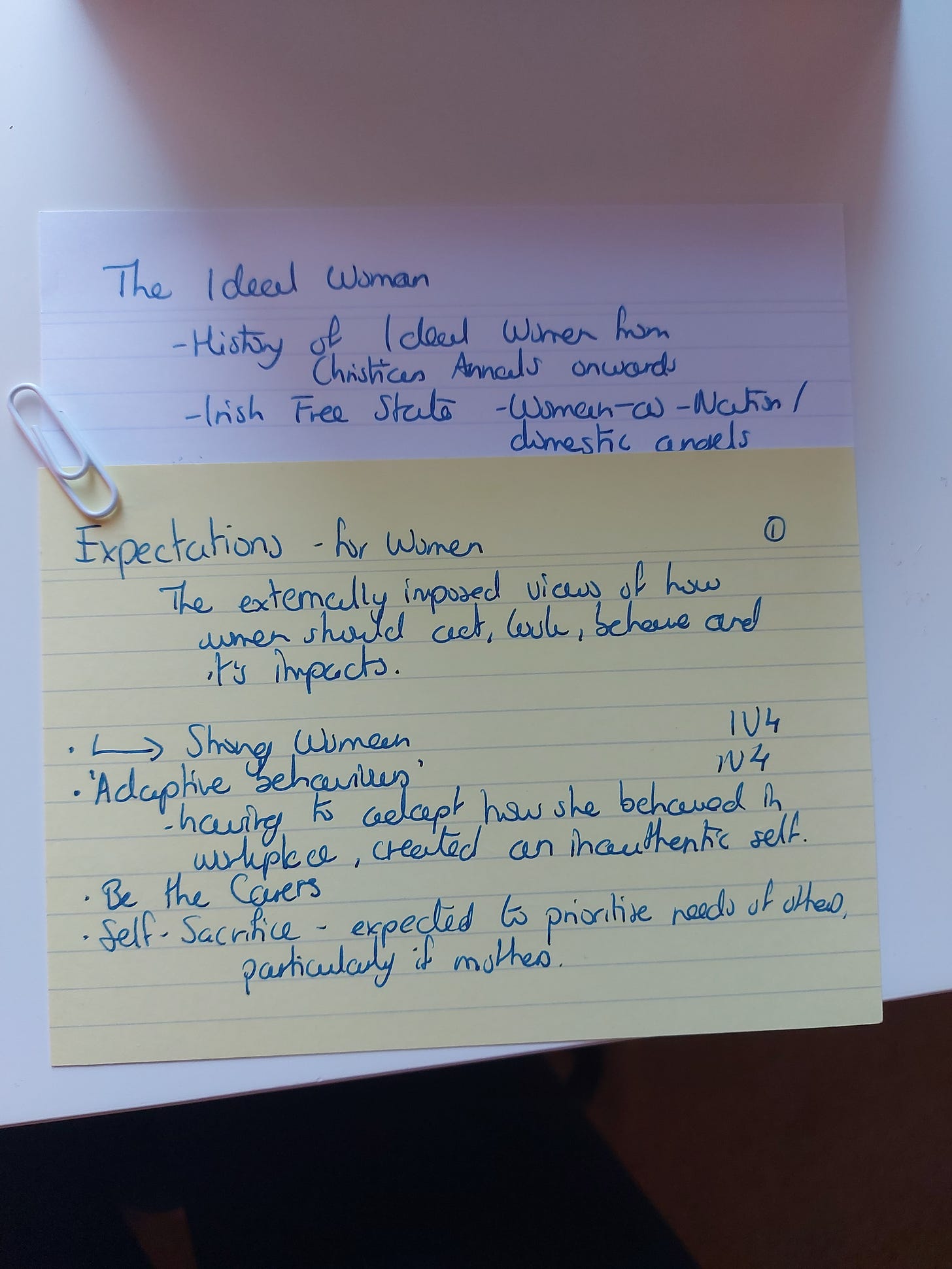I recently realised that, in the newsletters and articles I put out here on Substack, I often refer to ‘Women of Ireland Project’ interviews, ‘analysing interviews’ and ‘analysing data’ but I’ve never explained what that is or what that involves. It is just something that happens behind the scenes.
So, I thought, I’d make the above video, and write this piece, to explain what I mean when I refer to ‘women of Ireland project interviews’ or ‘analysing’ the women of Ireland project interviews.
Background and Interview Method
Between February 2021 and October 2022, I interviewed 36 women of Ireland, using something called a Biographical Narrative Interviewing Method (BNIM method)
That is pretty much just a fancy way of saying I asked people to tell me their life story, with the aim of exploring what it is like to be a woman of Ireland through the experiences of those 36 interview participants.
At the start of the interview, each participant was asked one main question:
Please can you tell me the story of your life, all the events and experiences which were important to you, about what it has been like to be a woman of Ireland?
And it’s from asking that question of the 36 wonderful women who gifted me their stories that I got my ‘interview data-set’ — which is made up of all the hours of interviewing of women’s first-hand accounts; their words and stories. So, when I mention ‘analysing interviews’ or ‘analysing data’ this is what I am referring to.
Analysing the interviews: a three-step process
Step 1: Highlighting according to three main themes
In this first step, I sit down with a hard copy of each interview and start reading through it with three highlighters to hand.
Each highlighter represents three different overarching and broad themes, a theme being a pattern that emerges from the data.
Green highlighter: societal factors
Pink highlighter: women’s collective experiences
Blue highlighter: individual experiences
As I read each line, I ask myself which theme best describes what is being said here? Which highlighter colour (theme) best captures what is being described/recounted/discussed? And highlight accordingly.
The aim at this point is just to organise the data really broadly into these three categories or ‘themes’.
As I’m doing this, I also do something called coding:
A code is a short phrase or word which captures the meaning of what is being said
In short, during Step One, as I’m reading through each interview, line by line, I’m categorising what is being said according to one of the three broad themes (thinking: which highlighter colour best captures what is being said?) and deciding what code — short phrase or word— would best capture what is being said.

Step 2: Main, more in-depth, analysis
This step is done on my laptop using a qualitative analysis software (which, unfortunately, does not do the analysis for me!) that enables me to get much more fine-grained and detailed about themes and codes that are emerging from the data.
First, I assign the three broad themes from Step One: the blue individual factors theme, the green societal factors theme, and the pink women’s collective experiences theme:
As I continue to analyse each interview, more and more, more specific themes, emerge from the interviews. I organise each of these under the most appropriate overarching theme (e.g. blue, green or pink) as sub-ordinate themes:
To go even deeper, and get more fine-grained in terms of organising and making sense of the data, each sub-theme will also have sub-codes (e.g. a word or a phrase that captures more specifically what is being said).
For example:
I interpreted what was being said in the above as someone being ‘slagged or teased’ so I assigned it a ‘slagging/teasing’ code:
‘Teasing’ is a mechanism of something known as “Tight Culture”: a culture where higher levels of social conformity are expected and enforced by society members (through things like teasing, judgement, shaming, ostracising etc.).
So, I ‘coded’ what was being said above as ‘Slagging/Teasing’ and because that is a mechanism of a “Tight Culture” I assigned it as a sub-code of the “Tight Culture Theme”, and because “Tight Culture” is something “Societal” I organised it under the overarching “Societal” theme (the green highlighter).
Applying this process, of coding and connecting a singular code to an overarching theme is the main part of the analysis in Step Two.
The goal of this stage is to organise the data and get a sense of what is emerging as really important themes (i.e. what themes are coming through as important for many of the participants).
Step 3: Collecting the gold and connecting it to the bigger picture
This step involves a box for holding index cards and two different card colours: yellow and white.
On the yellow index cards, I write down ‘gold nugget’ themes — the themes that are emerging out of the data analysis in Step Two as being really important and interconnected with other key themes— and file them alphabetically.
On the white cards I write down anything I have come across in other literature and in other research (e.g. historical, psychological, sociological, anthropological, literary, mythological, political, economic studies etc.) which would help me explain, illuminate or make sense of a theme (written on the yellow card) that is coming from the interviews.
For example:
Here, on the yellow card, I have an interview theme about the “Expectations” that women find are often placed on them. On the white card, I have written down historical factors relating to the “Ideals” expected of women in Ireland in the past which may help explain why Ireland has, historically, had quite strict norms and expectations for women — so I file these together.
When it comes to writing the book (which is my written response to these 36 interviews), I feel that much of these ‘golden nuggets’ will become key chapters or chapter sections. When I sit down to write those chapters, I imagine myself pulling out my yellow index cards to see what I’m writing about and then look at the white index cards to see what research I can draw on to help me further understand and explain the interview themes.
In short, the yellow cards explain the ‘what’ (what it is like to be a woman of Ireland) and the white cards help explain the ‘how’ (how we came to be the way we are).
At the moment, I am really in the thick of this analysis work, and it is what most of my time is dedicated to. It takes me about one to two weeks to analyse one interview through each of those three stages.
It’s a lengthy and time-consuming process and I have no intention of rushing it (even though the ‘be super-productive’ part of my self is screaming at the slowness) because I think the stories that have been generously shared with me deserve the time.
I hope this little insight into what I mean by ‘analysing data’ was understandable! If you have any questions or want to ask me anything about this ‘behind the scenes’ work, please do leave me a comment below or click reply (if getting this via email).
Belinda xx











Share this post